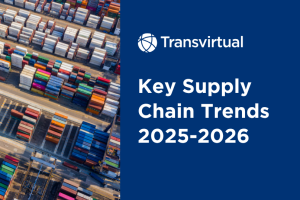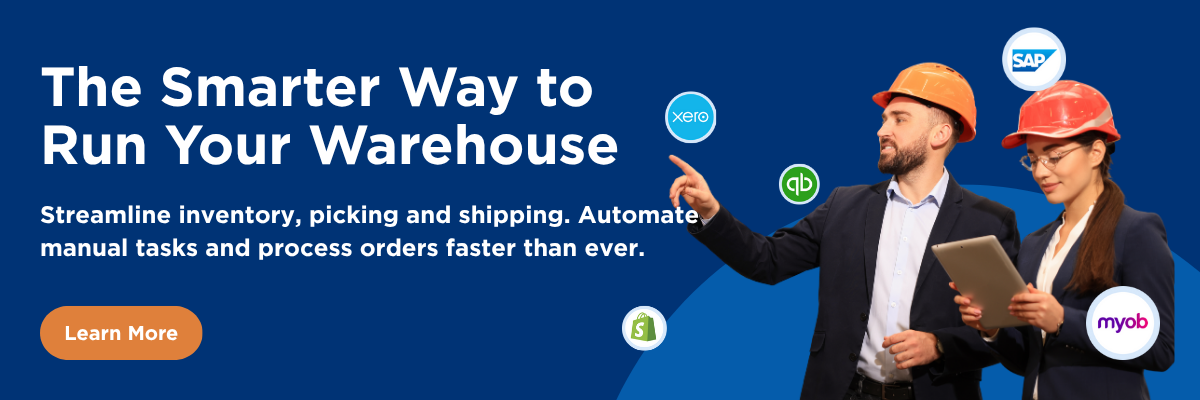Table of Contents
Supply chains around the world are transforming to respond to new trends and pressures from all sides. We have new tech, tighter regulations, geopolitical curveballs, and a world of consumers who demand faster, greener, and more consistent service.
Among these changes, key trends are emerging that will shape the logistics and supply chain sector for 2025 and 2026.
For your logistics and transportation industry business to stay ahead, you’ll need to be flexible and ready to pivot at a moment’s notice. Companies that embrace advanced technology, such as advanced data collection and logistics software tools, will position themselves at the leading edge of supply chain innovation, separating themselves from those scrambling to keep up with the pace of change.
What are the trends that define the next few years? Let’s start with possibly the most impactful of them all – the one that’s a driving factor in all the others.
As we look toward the future of the supply chain, preparing for new ways of delivering goods will be essential to meet evolving consumer expectations.
Understanding Modern Supply Chains
Today’s supply chains are intricate, global networks that connect suppliers, manufacturers, logistics providers, and customers in a web of interdependent relationships. Managing these supply chain operations requires a comprehensive understanding of the entire supply chain, from procurement and manufacturing to final delivery. Supply chain managers must be adept at identifying potential risks and uncovering opportunities for improvement at every stage.
Artificial intelligence, machine learning, and IoT devices provide businesses with real-time visibility into their supply chains, enabling them to make informed decisions that drive efficiency and growth. These advanced technologies empower organisations to optimise procurement, streamline manufacturing, and respond swiftly to changing market conditions, ensuring that both businesses and customers benefit from a more agile and responsive supply chain.
Artificial Intelligence in Everything
AI has quietly moved into just about every facet of modern logistics. And it doesn’t feel like science fiction, but a deeply practical nuts-and-bolts style of warehousing, fleet management, and fulfillment.
For example, only a few short years ago, supply chain managers had to rely on historical averages and their gut instincts for demand forecasting. Now, machine learning models parse thousands of variables in real-time to predict customer demand fluctuations days, weeks, or even months in advance.
According to Gartner, more than 80 percent of enterprises will use AI tools in their applications by 2026. These use cases will not be merely experimental, either – they’ll be standard operating procedures.
Beyond forecasting, AI has moved into procurement, supplier evaluation, route planning, and even autonomous decision-making in day-to-day operations. Tools powered by large language models are currently training to handle the most complex sourcing scenarios, detect anomalies, and assist in high-speed decision-making.
Warehouse floors have become less human as well, in positive ways. Autonomous mobile robots are now handling repetitive transport tasks, and robotic arms continue to improve in sorting and packing with extreme precision. Autonomous vehicles are increasingly being adopted for last-mile delivery, reducing manual labor in logistics and accelerating the transition toward fully autonomous operations on public roads. These advances all lead to faster fulfillment with fewer errors and a drop in overhead costs.
Big Data’s Big Job
Supply chains are always positively packed with numbers, but there’s a difference between having all that data and doing something with it. In 2025 and 2026, the context that allows decision-making will be far easier to acquire. Soon, big data sources will power every aspect of logistics, from real-time shipment tracking to customer transparency. Modern supply chain management (SCM) systems leverage big data to provide end-to-end visibility and improve decision-making across the entire supply chain.
The connected systems we will continue to use aren’t just pretty interfaces. They act as nerve centers that feed data from every scan, signature, delay, and delivery into unified platforms. These unified data platforms enhance SCM processes by integrating information and streamlining operations. Operations can be monitored, adjusted, and predicted with ease and accuracy. This enhances both visibility and operational awareness.
The payoff of all this data is larger than mere efficiency gains. It also reduces wasted inventory, makes ETAs more precise, prevents duplicated freight movements, and reduces fuel costs. If you’re a logistics provider operating at scale, even as a small- to mid-sized business with multiple contracts, using such data can mean the difference between profit and loss.
Data also helps your customers. You can provide clients with live views of their orders: what leg of the journey they’re on and whether to expect any holdups, all without necessitating a phone call. That kind of transparency reduces your workload and builds customer trust, while also ensuring the end user—the final recipient in the supply chain—has full visibility into their order status.
Cyber Security for Your Digital Warehouse
As business owners and operators, we rarely want to think about this threat until it’s too late. And the more our logistics operations go digital, the more they’ll become a magnet for cybercriminals. Ransomware attacks are no longer limited to banks or healthcare systems. Now, freight brokers, TMS platforms, and even warehouse IoT networks have become high-value targets.
It makes sense, too. One breach can stall deliveries, expose client data, and cascade through a huge range of connected systems. If your company runs lean, a single attack could lead to lost revenue, damaged client relationships, and potential legal fallout under several privacy laws.
That means cybersecurity has become a major part of supply chain risk management that can no longer be ignored. You may already have firewalls and antivirus software in place, but they won’t always be enough. You’ll need layered protection with endpoint security, encrypted communication, multi-factor authentication, and regular testing.
You also need to bake cyber hygiene right into your company culture. Everyone who handles a tablet or sits down to run dispatch software needs to know how to be careful at all times. It won’t always be server hacking that takes your system down – it could simply be an employee clicking the wrong link in a forwarded email.
Some modern TMS platforms like Transvirtual help mitigate this risk by operating in the cloud with strict security protocols and regular system updates. Still, your business must do its part, especially as your supply chain grows more interconnected than ever before.
Risk Management: Get Comfortable with Discomfort
In the past, we may have mentioned strategic “resilience” at the end of strategy documents right before the appendices began. Now, resilience headlines many documents, often written in bold. The last half-decade has thrown just about everything at our supply chains – global pandemics, semiconductor shortages, port shutdowns, cyberattacks, floods, fires, and famines. Supply chains must now anticipate potential disruptions at every turn.
In other words, disruption has become all too routine.
Operating in this world requires intelligent risk management through diversification. You can’t rely on a single supplier or in a single region. These risks become liabilities quickly. Smart businesses are widening their supplier bases, exploring nearshoring options, and betting strategically on regional partners capable of keeping the wheels turning when international routes stall out.
Stockpiling has become more popular as well. It may fly in the face of a lean inventory, but that buffer of essential components or products could mean the difference between delivering and closing shop altogether. Smart stockpiling powered by real-time data and AI can ensure your inventory is protected without being overly wasteful.
Planning is also of major importance. It might not feel glamorous as you do it, but asking those “what if” questions can help dramatically. If your supplier goes offline, if fuel costs double, if your routing system goes dark due to a cyberattack – having a plan of action in place is a primary way to mitigate risks and adapt to changing circumstances in the supply chain environment.
Companies should no longer treat risk management like boxes to tick off each quarter. Your risk management should be baked into everyday operations, from cybersecurity to collaborative networks of suppliers, tech partners, and customers that work together. Sharing information between these parties can help you avoid disruptions. Many organisations are now embedding risk management into their daily supply chain operations to improve resilience and performance.
The Global Trade Landscape Shifts
International trade routes are as essential as ever, but we can’t exclusively rely on our distant partners to keep our businesses healthy. As we’ve just covered, keeping our options this narrow poses some inordinate risks to guaranteed successful operations.
Strained diplomatic relationships, tariff troubles, port congestion, fuel volatility, and much more mean logistics providers must rethink their global footprint. That means more regionalism, with local or near-local sourcing. Our trade agreements must be more dynamic and prioritise flexibility over locking in for the long term.
Agility will be key for exporters. Cross-border tracking, customs integration, and transparent compliance reporting are necessary capabilities. For importers, they’ll need to build relationships in multiple markets if they want to reduce dependency and increase their resilience.
Strengthening Your Workforce Management
No algorithm can automate away a group of people who know what they’re doing (yet).
But the logistics landscape is evolving faster than ever. That means the talent pipeline must keep up with the tech that’s trying to race ahead of them. Now that AI, data analytics, and a wide range of digital platforms are frontline tools rather than the domain of IT specialists, your workforce must understand how to utilise them.
We’ve recently seen a rise in logistics upskilling programs, in-house academies, and a variety of cross-training initiatives that seek to blend old-school operational knowledge with new-school technological literacy. We don’t want to replace our humans. Instead, we want to augment them.
Imagine what an experienced dispatcher who acts on intuition to predict route delays could do with real-time data that backs their decision-making. Think about a warehouse manager who always expertly optimises floor space partnered with predictive software that flags bottlenecks before they happen.
Tech can also help reduce burnout by automating low-value tasks like data entry, duplicate communications, manual status updates, and more. However, workers can be overwhelmed by all this new tech if they aren’t given proper context or support.
That’s why modern software platforms like Transvirtual have user-friendly interfaces, role-based dashboards, and automation integrated into dispatch and delivery processes. Your teams lacking deep technical backgrounds can confidently step into the future without worrying about becoming obsolete.
The Cloud is the New Loading Dock
2025 and 2026 are already being defined by integration between systems, people, partners, and data streams. Supply chains are spiderwebbing networks rather than linear systems, and those networks require platforms. Cloud-based platforms support a variety of supply chain models, providing greater flexibility and integration for managing complex supply chain operations.
Your logistics operations should be built on a cloud-based infrastructure that allows every player in the supply chain (manufacturers, freight carriers, dispatchers, customers) to plug into the same ecosystem in real-time. They shouldn’t have to wait for email updates or rely on status reports that are outdated by the time they open them.
Systems interconnected via the cloud a shared awareness, one that enables decisions to be more collaborative. A warehouse delay in Melbourne may trigger a new ETA in Sydney, which alerts the customer automatically. A spike in fuel prices can alter route plans throughout the fleet. Responsiveness like this simply isn’t possible with paper-based processes.
Platforms like Transvirtual shine in these environments. Rather than having to cobble together tools from different vendors, you’ll have a platform that centralises dispatch, delivery tracking, PoD collection, invoicing, and customer communication. You’ll gain deeper integration with external systems and customisable workflows that adapt to unique operational needs, enabling your organisation to implement an effective supply chain strategy that can quickly adapt to changing market conditions.
Be Flexible and Ready
Supply chains aren’t getting easier, this year, next year, or ten years from now. They’re smarter, faster, more complex, and more unpredictable. But this can be a good thing, especially if your logistics company is willing to adapt. You can easily make 2025 and 2026 in logistics the most profitable years your business has seen yet. Many businesses are rethinking their supply chain strategies to address challenges from the earlier stages of raw material sourcing to the delivery of finished products.
The future favors those who lean into it. That means you should trust AI to make better calls than your gut instinct. That means embracing and learning from big data. It means treating cybersecurity seriously, like insurance. You’ll also need to treat your workforce like a power source, one that fuels your whole operation, while considering other factors such as human rights and sustainability in your supply chain decision-making.
You’ll also need the right tools to get the job done well every time. Transvirtual was designed for this future, to help transport and logistics streamline their decision-making, increase efficiency, and manage the chaos. We’re here to help you future-proof your supply chain.
To learn more about Transvirtual, schedule a free 10-minute strategy call, or speak directly to a representative at 1800 975 305 today.




